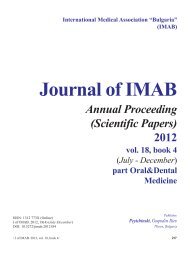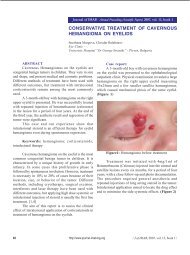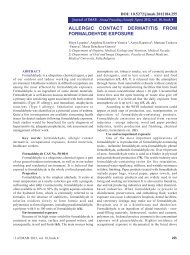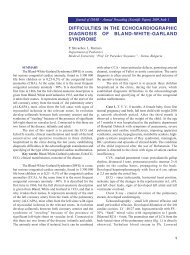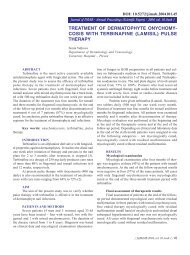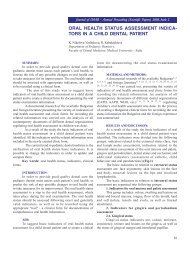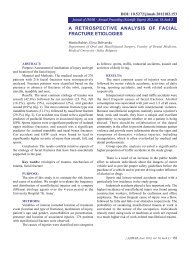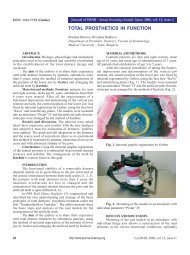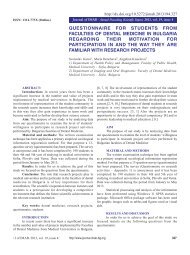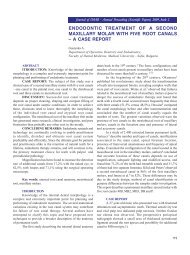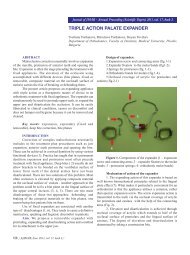download pdf - Academic Journals Database
download pdf - Academic Journals Database
download pdf - Academic Journals Database
Create successful ePaper yourself
Turn your PDF publications into a flip-book with our unique Google optimized e-Paper software.
4. To analyze the dependency of daily and labouractivities ensuing from the paretic limb-dominant (DL) ornon dominant (NDL).MATERIALS AND METHODSDuring the period 2011-2012 year 61 patients withconsequences of CVD (23 women and 38 men, 37 - 75years old), were admitted at the Department of HospitalRehabilitation and the Clinic of Physical medicine andrehabilitation, University Hospital “Dr. Georgi Stranski” –Pleven, Bulgaria.A right-sided paresis was found in 37 of the patients,34 of them were with NDL affected (table 1). The side ofthe paretic limb was of decisive importance for ADL (13-14).Table 1. Distribution of patients by DL and NDLaffectedAll of the patients followed physical rehabilitationprogram consistent with their individual status. It generallyincluded: kinesitherapy; labor therapy (OT and ADL),electrotherapy (15-17).All patients were tested for ADL at the beginningof the rehabilitation course . This test was created by H.Rusk at the Centre of medical rehabilitation , New York.Four stages were included in it - personal grooming andhygiene, putting on shoes, dressing; food preparation andfeeding; different social and labor activities (18).The assessment is based on a 6-grade score (from0 to 5), and the patients assessed themselves followingbasic activities no matter a dominant or NDL was affected:grade 0 - the tested patient cannot perform theactivity;grade 1 - the tested patient is trying to do theactivity but needs significant help;grade 2 - the tested patient is doing the activity, butneeds an assistant to oversee it;grade 3 - the tested patient is doing the activityslowly and with limited capacity;grade 4 - the tested patient is doing the activity withalmost normal power, velocity, coordination and durability;grade 5 – the tested patient performs the activitynormally, with good quality, totally independent;Signs (+) and (–) are given when marks are not full.For the purpose of our research, we focused onlyon ADL, particularly activities for preparing food andfeeding (19-21).The results from the first rehabilitationcourse were processed (subacute period at the start andat the end of the research). This was about one month afterthe stroke onset.Activities for preparing food and feeding: set in/pullout a plug, turning on/off a heater switch, turn on/off awater tab, washing up kitchen utensils, pouring anddrinking liquids in a cup, serving the food in a plate,feeding with a spoon, feeding with a fork, cutting productswith a knife, cleaning the table.These are activities from everyday life that everyperson confronts with. Using the switches of a heaterrequires significant strength for clutching and enoughvolume motion in the radio-ulnar joint. At the beginningof the rehabilitation process this is difficult, evenimpossible, for most of the patients. This situation requiresconsiderable support of the healthy limb, especially whenthe DL is paretic, grasping the clutch and supporting thelocomotion for turning over the switch.Switching on and especially switching off requiresconsiderable strength of the palmar grasp, acting of thehealthy limb is needed, while the paretic limb supports thecontact, (if possible) - figure 1).Fig. 1.The turning on/off of a tab water is not such adifficult activity, especially if it is a pick up/down nozzle,but if it is atraditional one, with hand clutches that turn, itrequires also considerable strength and enough motion in/ J of IMAB. 2013, vol. 19, issue 3 / http://www.journal-imab-bg.org 449



